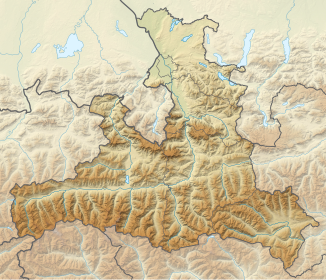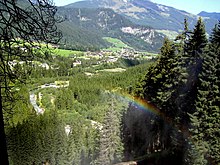Krimml waterfalls
| Krimml waterfalls | ||
|---|---|---|
|
Krimml waterfalls |
||
| Coordinates | 47 ° 11 '53 " N , 12 ° 10' 17" E | |
|
|
||
| place | Krimml , Salzburg , Austria | |
| Falling watercourse | Krimmler Ache ⋅ | |
| Estuarine waters | Krimmler Ache | |
The Krimml Waterfalls are the highest waterfalls in Austria with a total drop of 385 m . You are on the outskirts of Krimml ( Salzburg ) in the Hohe Tauern National Park . They are formed by the Krimmler Ache , which plunges down three steps at the end of the high Krimmler Achental. The water then flows into the Salzach , along the Pinzgau towards Salzburg and reaches the confluence with the Inn .
General
Emergence
The extraordinary height of fall (the upper, middle and lower Achenfall have a height of 145 m, 100 m and 140 m) results from the geological formation of this mountain region: The bulging of the central parts of the Alps about 30 million years ago, caused by the collision of the African with the Eurasian plate , the upper Salzach valley remained behind. This difference in altitude was increased during the Ice Age by a powerful ice flow that carved out the main valleys. The fact that the waterfall steps have been preserved at this height is explained by the fact that a zone of particularly hard rock ( granite ) emerges here ( Tauern window ), at the edge of which the waterfalls are located.
Amount of water
The Krimmler Ache is a typical glacier stream . 12% of its catchment area of 110.7 km² is glaciated, which results in a strongly changing water flow during the day and the year. In the months of June and July, about 5.6 m³ / s flow, whereas in February it is only about 0.14 m³ / s. The largest discharge so far was reached during the flood on August 25, 1987 with a maximum value of 166.7 m³ / s, which led to enormous destruction. The daily maximum of the runoff occurs between 9 pm and midnight, because the meltwater takes 9-12 hours to cover the 18 km from the glacier gate to the falls.
Economic use
The enormous amount of water combined with a great fall height naturally means a correspondingly high level of hydropower and thus of potentially recoverable electrical energy . As early as 1899 an attempt was made for the first time to “hand over the Krimml Waterfalls to the hands of an entrepreneur for factory purposes”. However, it was not realized. The main counter-arguments were, on the one hand, the rapidly changing amount of water, and on the other hand, tourism, which was already flourishing. In the years that followed, this was to continue to fend off desires on the part of the energy industry, until such considerations were finally off the table in 1967 when the Council of Europe was awarded the European Nature Conservation Diploma.
According to a study by the Paracelsus Medical Private University , the water mist is said to provide relief from asthma symptoms due to its content of electrically charged particles . However, experts criticize the informative value of the study as insufficient.
Waterfall path
Old Tauernweg
Already in the High Middle Ages there was a mule path along the waterfalls and the Achental over the Krimmler Tauern (2,633 m) to South Tyrol . As the most important commercial goods, salt is transported to the south and wine to the north. The Krimmler Tauernhaus , which is still in use today, is an important rest station and was first mentioned in a document in 1389.
In the 16th century, the mule traffic over the Krimmler Tauern was obviously so significant that a new route was created. The surrounding nature does not interest the travelers of the time. The Krimmler Tauernweg is laid out accordingly: it only leads to the waterfalls if the terrain makes it absolutely necessary.
Tourist development
It was not until the 18th century that the English in particular began to travel voluntarily - often out of scientific interest. So that travelers can see more of the Krimml waterfalls without much effort, the caretaker from Mittersill, Ignaz von Kürsinger , had a path built to the upper end of the lower falls around 1835, "and there was a tourist and painter's house" (cameras were still there not common). In 1879, the Pinzgau section of the German and Austrian Alpine Club expanded the Krimmler Tauernweg into a scenic trail.
Path by the waterfall since the beginning of the 20th century
The Warnsdorf section laid the trail in 1901. The construction had become necessary because after the construction of the Pinzgauer local railway from Zell am See to Krimml in 1897 the number of visitors had increased drastically (1905: 8,600 visitors). From 1904, the section on the Krimmler Wasserfallweg began collecting a toll for the maintenance costs of the path (1904: 36 Heller, 2004: € 1.50, 2006: € 1.80, 2008: € 2, 2010: € 2.50, 2014: 3.00 € 2020: 4.00 €). The path now runs close to the waterfall and winds up in narrow and steep serpentines. Therefore, visitors should be in good shape if they want to fully climb the waterfall. There are very beautiful views from several viewing platforms. The path belongs to the Warnsdorf / Krimml section of the Austrian Alpine Club , which takes care of maintenance and safety.
Visitor numbers
In the 2010s, the Krimml Waterfalls were one of the major tourist attractions in Austria with an average of 400,000 visitors, which in addition to the positive effects on the local economy also brought problems. These include, on the one hand, the traffic load and, on the other hand, the footfall and erosion damage in the area of the path.
Hiking opportunities
After the ascent to the upper edge of the falls along the waterfall path (approx. One hour), there are various options for hiking along the Krimmler Achental: After two hours, the Krimmler Tauernhaus (1,631 m) can be reached. From there you can either follow the Achental to Warnsdorfer Hütte (2,336 m, three hours, Warnsdorf / Krimml section) or turn into Rainbachtal and after three hours you can reach Richterhütte (2,374 m, Bergfreunde / Rheydt section).
Medicinal deposits
The water molecules of the Krimml waterfalls are said to be "ionically (negatively) charged by the violent impact on the rock and shattered into tiny fragments", "which are 200 times smaller than in an asthma spray." As a result, they should "be particularly deep into the airways when inhaled." (...) "and staying at the waterfall should have" positive and lasting effects on allergies and asthma ". This is why the waterfalls were recognized by the state government in 2015 as a “natural, local healing resource” according to the Salzburg healing resources and health resort law. The scientific evidence for such a healing effect is criticized by experts.
Traffic connection
The Salzburg bus routes 670 and 671 currently stop at the nearby Krimmler Wasserfälle stop . There are extensive visitor parking spaces next to the bus stop. The municipality of Krimml has plans to extend the Pinzgauer Lokalbahn , which currently ends in Vorderkrimmel, to the aforementioned bus stop.
literature
- Slupetzky, Heinz and Wiesenegger, Johannes: From snow, ice, meltwater and rain to the glacier creek - hydrology of the "Krimmler Ache" , in: Krimmler Wasserfälle, Festschrift 25 Years European Nature Conservation Diploma 1967–1992 , Innsbruck 1993
- Stocker, Erich: On the geomorphology of the Krimmler waterfalls , in: Krimmler waterfalls, commemorative publication 25 years of European nature conservation diploma 1967–1992 , Innsbruck 1993
Web links
Individual evidence
- ↑ Archived copy ( Memento of the original from March 24, 2015 in the Internet Archive ) Info: The archive link was inserted automatically and has not yet been checked. Please check the original and archive link according to the instructions and then remove this notice.
- ↑ Gaisberger M, Šanović R, Dobias H, Kolarž P, Moder A, Thalhamer J, Selimović A, Huttegger I, Ritter M, Hartl A: Effects of ionized waterfall aerosol on pediatric allergic asthma. J asthma. 2012 Oct; 49 (8): 830-8. PMID 22861198
- ↑ a b Waterfalls against asthma: Effect questionable on www.medizin-transparent.at, accessed on October 17, 2018
- ↑ Krimml waterfalls heal naturally . In: Salzburger Landeskorrespondenz, June 9, 2015.





